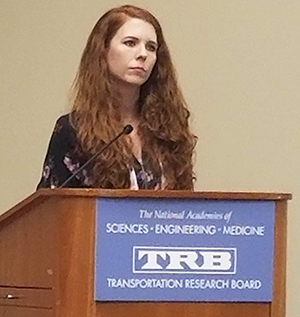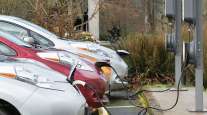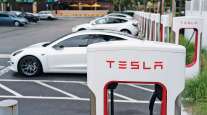Staff Reporter
Parcel Lockers, EVs Combine for Energy Savings in Final Mile, Researcher Says
WASHINGTON — Electric trucks and vans show great promise for energy savings in making suburban deliveries for companies such as UPS Inc., according to an Oak Ridge National Laboratory scientist who presented her findings to a forum at the Transportation Research Board’s annual meeting.
The final mile, as it is known, is often the least efficient part of deliveries. Finding methods and technology to make final-mile delivery more efficient and easier was a hot topic at the 98th meeting of TRB.

Moore talks about her research on final-mile efficiencies at TRB. (Jim Stinson/Transport Topics)
Oak Ridge researcher Amy Moore told an audience of about 100 on Jan. 15 that UPS agreed to give her data for 21 delivery trucks in part of northern Columbus, Ohio, during July 2017.
But that area is not downtown, nor is it very densely developed. The hub is in western Columbus, beyond the Interstate 270 loop.
UPS gave Moore the vehicle speeds, times and dates, fuel consumption data, coolant temperatures and engine speeds.
Moore then took the data and analyzed how other forms of innovative final-mile delivery would perform. Moore said she wanted to see energy savings if UPS had instead used drones, lockers, fully electric trucks and a combination of fully electric trucks working with fully electric vans making the final stop.
One conclusion Moore reached was that land-based final mile, powered by electricity, was a much better option to save energy.
“[Drones] really are not as efficient as people think,” Moore told Transport Topics after the presentation.
I am a big fan of parcel lockers.
Amy Moore, Oak Ridge National Laboratory
Moore found that drones only saved 13% in energy. She found parcel lockers located in spread-out neighborhoods saving the most energy for UPS, when combined with delivery via electric vehicles.
“I am a big fan of parcel lockers,” Moore said.
Combined with electric vehicles, lockers saved 88% in energy. Moore cautioned that doesn’t include customer energy to get to the neighborhood lockers.
Her research found 54% of package volume weighed 5 pounds or less. About 83% of volume weighed 20 pounds or less.
To deliver these packages, electric trucks driving into the area combined with electric vans also saved energy for UPS, Moore found.
The final-mile trucking sector is one drawing investment as well as research. On Jan. 8, J.B. Hunt Transport Services Inc. announced it bought Cory 1st Choice Home Delivery for $100 million. E-commerce appears to be driving much of the growth and interest in final-mile efficiencies.
Moore’s study is part of the U.S. Department of Energy’s research on multimodal mobility.
TRB is the world’s largest gathering of transportation professionals, and this year’s meeting ran from Jan. 13-17. More than 13,000 people were expected to attend.




